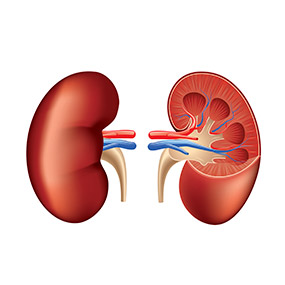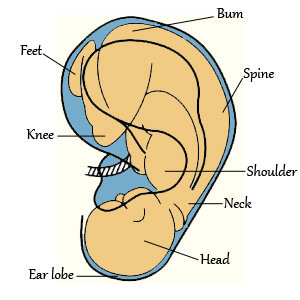In this article, we delve into human ears and how they are a possible road map to predict the state of our health!
In traditional Chinese medicine, it is believed our human body from our lips, nose to ears have a correlated relationship with our internal organs. Hence, just by observing these specific organs, we can gather clues about our state of health.
Here, we start off with our human ears—the organ of hearing, which transmits and transduces soundwaves to the brain. Human ears are telling organs that could reveal our present health conditions, as well as our future health issues.
Hence, we’ve gathered useful information to help you better understand your health conditions! Do note that the below information may not be absolute indicators. Please consult your doctor for further diagnosis.
How your ear reveals about you?
1. Our ears are just like fingerprints
Our ears are fully developed when we’re born. Though our lobes will descend as we age, but our ears remain almost the same as time passes. As a matter of fact, the ears’ unique characteristics, differ from person to person. This implies that they could serve as a mean of identification, just like our fingerprints.
2. Recessive or dominant genes
You have the recessive gene if your earlobes are attached completely to the side of your head. People with recessive trait are genuine, diligent, devoted and focused.
You have dominant gene if you have free earlobes that hang down beyond the attached point. Those with dominant trait are spontaneous and free-spirited person, who lives life one day at a time.
3. Diagonal earlobe crease is an indication of coronary artery diseases
The diagonal ear lobe crease has long been characterized in the medical literature, for example, an open letter by Dr Sanders T. Frank, published in the New England Journal of Medicine in 1973, as an indicator to identify the likelihood of patients developing coronary artery diseases, such as atherosclerosis.
This has been verified by another study published in 1989, which analyzed the bodies of 300 deceased patients. The researcher in this study concluded, “We found a strong association between earlobe creases and a cardiovascular cause of death in men and women after age, height, and diabetes had been controlled for.”
Scientists noted that the diagonal earlobe crease is formed due to the degeneration of the elastic tissue around the small blood vessels that carry blood to the earlobes.
Hence, if you have a diagonal earlobe crease or “Frank’s sign”, it’s a telling sign that you stand a high risk of developing coronary artery disease.
4. Pale-colored ear is a sign of vitamins and calcium insufficiency
If your ears are pale in color, it could be a sign of vitamin C or D, and calcium insufficiency. It could also mean you’re dehydrated.
5. Your ears are related to the state of your kidney
According to Chinese Traditional medicine, the ear resembles the kidney. Thus, our ears thought to be related to the state of kidney jing.
Just as the Huang Di Nei Jing (Yellow Emperor’s Inner Canon), the earliest ancient treatise of Traditional Chinese Medicine written by Chinese emperor Huangdi around 2600 BC, stated: “The kidney qi communicates with the ears; if the kidney functions properly, the ears can distinguish the five essential sounds.”
As such, ear problems, such as deafness, tinnitus, or ear infections are an indication that your kidney’s energy needs to be replenished.
And red, flushed ear could be a sign of adrenal insufficiency, or an overworked kidney.
Large ears and sharp hearing could also imply an excellent state of kidney jing. Age-related hearing loss could be the result of jing depletion as a person gets older.
Small ears could also denote a greater probability of developing eczema and kidney disease.
6. Deep red colored ears are sign of brain disorders
If your ears are a deep red color all the time, it could signal memory loss, constant headaches and brain problems.
7. Inflammation of the cartilage of the ear is a symptom of a disease known as relapsing polychondritis
Inflammation of the cartilage of the ear is a symptom of relapsing polychondritis, an autoimmune disease which brings about inflammation of the cartilage in many areas of the body.
It could also be caused by ear cartilage infection, external factors such as mechanical pressure from telephones, environmental factor like radiation exposure, or irritants.
8. Excess earwax is an indication of essential fatty acid deficiency
It is believed that excess wax buildup is likely to be caused by the lack of essential fatty acid deficiency.
Essential fatty acids such as Omega 3, is essential in preventing cardiovascular disease, and enlarged prostate. It also helps to maintain normal brain cell membranes, regulate inflammation, and in keeping our skin soft.
And, bear in mind, an excess accumulation of earwax could trigger in some loss of hearing.
9. Wet earwax, smelly armpit and breast cancer

In a study published in the FASEB journal in 2009, Japanese scientists found that earwax and breast cancer might be genetically linked.(Credits: pixabay.com)
In a study published in the FASEB journal in 2009, Japanese scientists came to the conclusion that the variant of the gene ABCC11, commonly found in people of East Asian descent, induces smelly armpits and wet ear wax and is linked to a higher risk of breast cancer.
Please note that the study only suggests odorous armpits and wet ear wax to be one of the factors for prediction of breast cancer risk, and not all women are liable to breast cancer if they have these two conditions.
“We do strongly hope that our study will provide a new tool for better prediction of breast cancer risk,” Toshi Ishikawa, PhD, professor of biomolecular engineering at the Tokyo Institute of Technology and the senior author of the study.

In a study published in the FASEB journal in 2009, Japanese scientists found that earwax and breast cancer might be genetically linked.(Credits: pixabay.com)
10. Ringing Ears could be a sign of chronic tinnitus
According to the Harvard Medical School Harvard Health Publications, if you hear continuous ringing and buzzing in the ears for more than six months, you’re likely to have chronic tinnitus.
Reflexology of the ear
Reflexology is an alternative treatment derived from Chinese traditional medicine. It is a therapeutic method to relieve pain by applying pressure on the various reflex points on our feet, hands, head and ears.
And ear reflexology had its presence discovered in Chinese medical work thousands year ago, and has been deployed by people in ancient Egypt, Rome, Greece and all the Mediterranean area. It was first introduced in in France in 1950 by Paul Nogier, who is known to the Father of modern ear acupuncture.
Our ears is another body organ that is widely believed to be linked to other internal organs of the body and the musculoskeletal system through 200 or more acupuncture points. Thus, by pressing on the various reflex points, it could ease health problems, relieve pain and stress, as well as treating addiction.
An ear reflexology ear chart shows the connection between the ear and an unborn baby in fetal position
So where exactly are these reflex points?
The picture below depicts the six major reflex points.
You can massage or use a clothes peg to apply pressure on these points to relieve minor pain in the associated areas. We advise you to consult a doctor if the problem persists.
1. Back and shoulders
Applying pressure at the tip of your ear could ease soreness in your back and shoulders.
2. Organs
Massaging the point just below the tip of your ear could relieve minor internal pain.
3. Joints
Massaging the point in the upper-middle part of the ear resolves joint pain due to a change of season or arthritis.
4. Nasal sinuses and throat
Apply pressure to the lower-middle part of your ear could alleviate cold, sinus and throat soreness.
5. Digestion
Massaging the point just above the lobe could eliminate digestive problems, such as digestive discomfort, bloating and gas.
6. Head and heart
Apply pressure on the lowest part on the earlobe for a good heart health or to get rid of headaches.
——————————————————
1. Back and shoulders
Applying pressure at the tip of your ear could ease soreness in your back and shoulders.
2. Organs
Massaging the point just below the tip of your ear could relieve minor internal pain.
3. Joints
Massaging the point in the upper-middle part of the ear resolves joint pain due to a change of season or arthritis.
4. Nasal sinuses and throat
Apply pressure to the lower-middle part of your ear could alleviate cold, sinus and throat soreness.
5. Digestion
Massaging the point just above the lobe could eliminate digestive problems, such as digestive discomfort, bloating and gas.
6. Head and heart
Apply pressure on the lowest part on the earlobe for a good heart health or to get rid of headaches.
——————————————————








